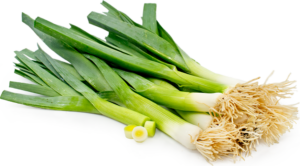“Eat leeks in March and wild garlic in May and all year after physicians may play” — traditional saying
Leeks are members of the onion family but have a more mild flavor.

FAST FACTS
Benefits and nutritional information:
- While most people think of leeks as something to add to soup, where their sweet, oniony flavor adds depth, they are being used more and more in a variety of other dishes as well as being appreciated on their own as a side-dish.
Starting:
- Seeds should be sown about an inch apart in pots or trays, then covered with a thin layer of potting soil and watered in.
- Sowings should be placed in a sunny indoor windowsill or a greenhouse. Keep the potting soil moist but not too wet.
- To encourage the plants to develop strong roots and a stocky stature, use scissors to give them weekly haircuts. Cutting off all but the bottom 2” of the plant will help force the plant’s energy back into the roots.
- Begin hardening off the seedlings a couple of weeks before planting them outside.
- When planting outside, plant seedlings 6” to 8” apart in rows 18” to 24” apart. It’s recommended that transplanting be done by poking a hole in the soil with a “dibble” or a broomstick end and setting the plant in the hole.
- To maximize space, grow quick-growing salad leaves in between your newly planted leeks. These will need to be harvested by mid-summer, when the leeks will need the space to grow well.
- As leeks grow, mound soil around the base of the plant.
When to plant:
- Since leeks can take from 120 to 150 days to reach maturity after planting seeds, the process of growing them is more complicated than for most vegetables. In essence, leeks should be started inside during late winter and grown to from 6” to 8” in height before being transplanted out into the garden bed.
Signs of over-watering, nutrient deficiency
- Overwatering leeks leads to infestations of fungal diseases.
- Leeks are “heavy feeders” and need regular applications of organic fertilizer that is high in phosphorus. Lack of nutrients will result in smaller leaves.
Pests and pest controls
- Young seedlings are susceptible to damping off.
- Older plants may be infested by downy mildew or rust.
- Leaves and bulbs may also develop black, dusty lesions due to onion smut
- Insect pests include thrips, leaf miner or onion maggots.
Harvesting
- Harvest your leeks as soon as they’re big enough for your needs. Lever it out of the soil using a fork, while pulling up on the leaves. Trim the roots and any damaged leaves onto the compost heap and rinse off the soil.
